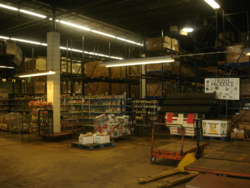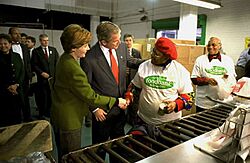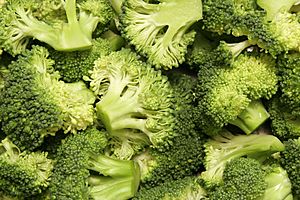Capital Area Food Bank facts for kids
 |
|
| Formation | October 24, 1979 |
|---|---|
| Type | 501(c)(3) nonprofit organization |
| Headquarters | Michigan Park, Washington, D.C. |
|
Region
|
Washington metropolitan area |
| Services | Hunger relief, nutrition education, healthy food access |
|
Founder and former President
|
Lynn Brantley (1980–2012) |
|
Former President and CEO
|
Nancy Roman (2013–2017) |
|
President and CEO
|
Radha Muthiah (2018– ) |
|
Board Chairman
|
Peter Schnall |
|
Parent organization
|
Feeding America |
| Subsidiaries | Capital Area Food Bank Foundation |
|
Revenue (2014)
|
$53,559,173 |
| Expenses (2014) | $59,912,375 |
|
Staff (2013)
|
153 |
|
Volunteers (2013)
|
21,000 |
The Capital Area Food Bank is a big organization in the Washington metropolitan area. It helps people who are hungry. They also work to prevent health problems like poor nutrition and diabetes.
They team up with over 450 groups in Washington, D.C., Maryland, and Virginia. They also deliver food to places that are hard to reach. Each year, the Capital Area Food Bank helps almost half a million people get healthy food.
In 2015, the food bank gave out nearly 45 million pounds of food. This was enough for 36 million meals. Besides food, they teach people about nutrition and how to cook healthy meals. They help families learn to shop and cook good food on a budget.
The Capital Area Food Bank serves many areas. These include Washington, D.C., and counties in Maryland and Virginia. Some of these are Montgomery, Prince George's, Arlington, and Fairfax.
About 21,000 volunteers help the food bank every year. They sort food, teach classes, and do other important jobs. The food bank is part of Feeding America, a national network.
Contents
History of the Food Bank
The Capital Area Food Bank officially started on October 24, 1979. However, they consider January 15, 1980, their founding date. This was Martin Luther King Jr.'s fifty-first birthday. Before this, the government's Food Stamp Program was the main way to help hungry people.
But in the early 1980s, there were plans to cut the Food Stamp Program. So, two local groups, the United Planning Organization and the Interfaith Conference, started the food bank. In its first year, the food bank helped almost 100 organizations. They delivered 1,540 pounds (700 kilograms) of food each month.
Throughout the 1980s, the Capital Area Food Bank grew. They worked with nearby companies like The Washington Post.
Expanding Warehouses and Services
In 1991, the Capital Area Food Bank opened a new warehouse. It was in the Brookland neighborhood of northeast Washington, D.C.. This new warehouse was 48,000 square feet (4,459 square meters). This was more than three times bigger than their first 14,000 square foot (1,300 square meter) warehouse. This larger space is still used today.
In 1998, another warehouse opened in Lorton, Virginia. This warehouse helps people in Northern Virginia.
In 2004, the first "Blue Jeans Ball" event was held. It was called the "Farmer's Blue Jeans Ball" back then.
In 1981, the food bank handled just over one million pounds (460,000 kilograms) of food. Less than 25 years later, in 2005, they gave out over 20 million pounds (9 million kilograms) of food. This helped over 275,000 people. This made it the biggest food bank in the area.
By 2007, the Capital Area Food Bank gave out 20 million pounds of food. They helped about 383,000 people in the Washington metro area.
In 2012, the food bank moved to the Bedford Falls Foundation Distribution Center. This move helped them give out much more food. It also allowed them to have more space for education programs.
In 2013, the Urban Demonstration Garden finished its first growing season. This 8,000-square-foot garden is behind the food bank. It is a place to grow food and teach others.
By 2014, the Capital Area Food Bank reached 540,300 people. They provided 42 million pounds of food. They also started the Fruits and Vegetables Fund for Greater Washington. This fund helps the food bank grow fresh produce with local farmers.
In 2016, the food bank started a new policy for accepting food. They wanted foods lower in sugar and salt, and higher in fiber. With help from stores, donations of unhealthy foods dropped by 84% in one year.
In 2017, cooking information became available to many more people. The food bank's recipe cards were put in all 93 Giant grocery stores in the area. These cards show how to make a healthy meal for a family of four for $7 or less.
Political Support for the Food Bank
The Capital Area Food Bank is close to the U.S. government. This makes it a popular place for politicians to visit. Four U.S. presidents have visited the food bank. These include George H. W. Bush, Bill Clinton, George W. Bush, and Barack Obama.
In 1990, President George H.W. Bush said he did not like broccoli. In response, about ten tons of broccoli were sent to the White House. Barbara Bush, the First Lady, then donated all of it to the Capital Area Food Bank. That same year, the president visited the food bank. He included it in his Points of Light Foundation.
On Inauguration Day in 1993, over 35,000 cans of food were collected for the food bank. This included a donation from Tipper Gore. In 1999, President Bill Clinton volunteered at the food bank. George W. Bush did the same in 2002.
In 2004, before Super Bowl XXXVIII, Laura Bush, the U.S. First Lady, visited the food bank. She encouraged Americans to help charities. Other politicians have also supported the food bank. In 2005, Congressmen from Maryland and Virginia helped get US$1.3 million in federal money for the food bank.
Client Leadership Councils
The Capital Area Food Bank (CAFB) uses Client Leadership Councils (CLCs). These are groups of people who face food insecurity in the D.C. area. They rely on CAFB for healthy food.
Each CLC has about two dozen members. They go through training for nine months. They learn how to share their stories and help with advocacy. They also learn to talk to the press. These members help shape CAFB's plans and government policies.
People over 18 who live in the food bank's service area can apply. They must also be food insecure and use CAFB's services. CAFB works with partner groups to find many different applicants. Each person is interviewed to make sure they fit the group. This helps make sure the group represents all the people CAFB helps.
CLC meetings run from September to May. Members attend three-day training sessions each month. They learn new skills and hear from experts on food security. They also make suggestions for CAFB and local officials. As time goes on, they work with CAFB staff to make approved changes happen. All CLC members are paid for their time. Their travel costs to meetings are also covered.
The CLC program has greatly changed how CAFB and local lawmakers fight food insecurity. They have helped with policies like the Virginia Dream Act. They also helped get funding in the D.C. Mayoral budget. They have improved CAFB's food distribution network. They also helped add fresh produce to monthly food boxes. CLCs have helped CAFB understand different nutrition needs by age and background.
See also
- Feeding America – the national food bank network that includes the Capital Area Food Bank
- List of food banks




